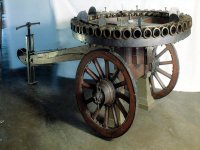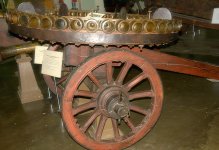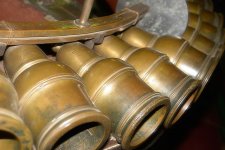Both of these rotating cannon devices just where the hell is the fire hole?
Assuming of course gunpowder is the propellant it has to be lit by something. Firing holes are not in evidence.
Also why does the drawing of the device depict two cannons being fired at once in different directions?
Surely the probability of killing your own team is too high for these devices to ever have been used in anger.
As a slight aside why are the men in these drawings so badly posed?
As for #2 the one I said I had no clue about well on second glance it looks like it could be a mortar in a loading positio. The round dot about midway up its length suggests its actually a pivot which is used to change the loaded mortar to precise angles to fire.
No fire hole visible just like the cannon contraptions.






